Jean-Marc Valin
RADE: A Neural Codec for Transmitting Speech over HF Radio Channels
May 10, 2025Abstract:Speech compression is commonly used to send voice over radio channels in applications such as mobile telephony and two-way push-to-talk (PTT) radio. In classical systems, the speech codec is combined with forward error correction, modulation and radio hardware. In this paper we describe an autoencoder that replaces many of the traditional signal processing elements with a neural network. The encoder takes a vocoder feature set (short term spectrum, pitch, voicing), and produces discrete time, but continuously valued quadrature amplitude modulation (QAM) symbols. We use orthogonal frequency domain multiplexing (OFDM) to send and receive these symbols over high frequency (HF) radio channels. The decoder converts received QAM symbols to vocoder features suitable for synthesis. The autoencoder has been trained to be robust to additive Gaussian noise and multipath channel impairments while simultaneously maintaining a Peak To Average Power Ratio (PAPR) of less than 1~dB. Over simulated and real world HF radio channels we have achieved output speech intelligibility that clearly surpasses existing analog and digital radio systems over a range of SNRs.
Very Low Complexity Speech Synthesis Using Framewise Autoregressive GAN (FARGAN) with Pitch Prediction
May 31, 2024Abstract:Neural vocoders are now being used in a wide range of speech processing applications. In many of those applications, the vocoder can be the most complex component, so finding lower complexity algorithms can lead to significant practical benefits. In this work, we propose FARGAN, an autoregressive vocoder that takes advantage of long-term pitch prediction to synthesize high-quality speech in small subframes, without the need for teacher-forcing. Experimental results show that the proposed 600~MFLOPS FARGAN vocoder can achieve both higher quality and lower complexity than existing low-complexity vocoders. The quality even matches that of existing higher-complexity vocoders.
Real-time Stereo Speech Enhancement with Spatial-Cue Preservation based on Dual-Path Structure
Feb 01, 2024Abstract:We introduce a real-time, multichannel speech enhancement algorithm which maintains the spatial cues of stereo recordings including two speech sources. Recognizing that each source has unique spatial information, our method utilizes a dual-path structure, ensuring the spatial cues remain unaffected during enhancement by applying source-specific common-band gain. This method also seamlessly integrates pretrained monaural speech enhancement, eliminating the need for retraining on stereo inputs. Source separation from stereo mixtures is achieved via spatial beamforming, with the steering vector for each source being adaptively updated using post-enhancement output signal. This ensures accurate tracking of the spatial information. The final stereo output is derived by merging the spatial images of the enhanced sources, with its efficacy not heavily reliant on the separation performance of the beamforming. The algorithm runs in real-time on 10-ms frames with a 40 ms of look-ahead. Evaluations reveal its effectiveness in enhancing speech and preserving spatial cues in both fully and sparsely overlapped mixtures.
Noise-Robust DSP-Assisted Neural Pitch Estimation with Very Low Complexity
Sep 25, 2023Abstract:Pitch estimation is an essential step of many speech processing algorithms, including speech coding, synthesis, and enhancement. Recently, pitch estimators based on deep neural networks (DNNs) have have been outperforming well-established DSP-based techniques. Unfortunately, these new estimators can be impractical to deploy in real-time systems, both because of their relatively high complexity, and the fact that some require significant lookahead. We show that a hybrid estimator using a small deep neural network (DNN) with traditional DSP-based features can match or exceed the performance of pure DNN-based models, with a complexity and algorithmic delay comparable to traditional DSP-based algorithms. We further demonstrate that this hybrid approach can provide benefits for a neural vocoding task.
NoLACE: Improving Low-Complexity Speech Codec Enhancement Through Adaptive Temporal Shaping
Sep 25, 2023Abstract:Speech codec enhancement methods are designed to remove distortions added by speech codecs. While classical methods are very low in complexity and add zero delay, their effectiveness is rather limited. Compared to that, DNN-based methods deliver higher quality but they are typically high in complexity and/or require delay. The recently proposed Linear Adaptive Coding Enhancer (LACE) addresses this problem by combining DNNs with classical long-term/short-term postfiltering resulting in a causal low-complexity model. A short-coming of the LACE model is, however, that quality quickly saturates when the model size is scaled up. To mitigate this problem, we propose a novel adatpive temporal shaping module that adds high temporal resolution to the LACE model resulting in the Non-Linear Adaptive Coding Enhancer (NoLACE). We adapt NoLACE to enhance the Opus codec and show that NoLACE significantly outperforms both the Opus baseline and an enlarged LACE model at 6, 9 and 12 kb/s. We also show that LACE and NoLACE are well-behaved when used with an ASR system.
LACE: A light-weight, causal model for enhancing coded speech through adaptive convolutions
Jul 13, 2023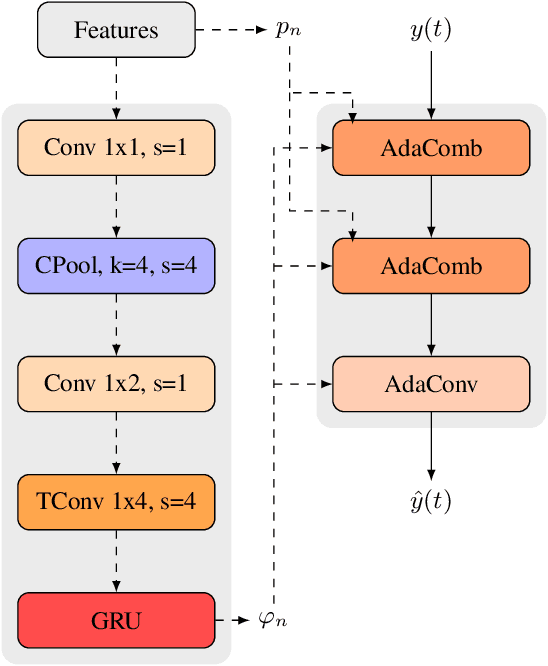



Abstract:Classical speech coding uses low-complexity postfilters with zero lookahead to enhance the quality of coded speech, but their effectiveness is limited by their simplicity. Deep Neural Networks (DNNs) can be much more effective, but require high complexity and model size, or added delay. We propose a DNN model that generates classical filter kernels on a per-frame basis with a model of just 300~K parameters and 100~MFLOPS complexity, which is a practical complexity for desktop or mobile device CPUs. The lack of added delay allows it to be integrated into the Opus codec, and we demonstrate that it enables effective wideband encoding for bitrates down to 6 kb/s.
A Framework for Unified Real-time Personalized and Non-Personalized Speech Enhancement
Feb 23, 2023



Abstract:In this study, we present an approach to train a single speech enhancement network that can perform both personalized and non-personalized speech enhancement. This is achieved by incorporating a frame-wise conditioning input that specifies the type of enhancement output. To improve the quality of the enhanced output and mitigate oversuppression, we experiment with re-weighting frames by the presence or absence of speech activity and applying augmentations to speaker embeddings. By training under a multi-task learning setting, we empirically show that the proposed unified model obtains promising results on both personalized and non-personalized speech enhancement benchmarks and reaches similar performance to models that are trained specialized for either task. The strong performance of the proposed method demonstrates that the unified model is a more economical alternative compared to keeping separate task-specific models during inference.
Low-Bitrate Redundancy Coding of Speech Using a Rate-Distortion-Optimized Variational Autoencoder
Dec 08, 2022Abstract:Robustness to packet loss is one of the main ongoing challenges in real-time speech communication. Deep packet loss concealment (PLC) techniques have recently demonstrated improved quality compared to traditional PLC. Despite that, all PLC techniques hit fundamental limitations when too much acoustic information is lost. To reduce losses in the first place, data is commonly sent multiple times using various redundancy mechanisms. We propose a neural speech coder specifically optimized to transmit a large amount of overlapping redundancy at a very low bitrate, up to 50x redundancy using less than 32~kb/s. Results show that the proposed redundancy is more effective than the existing Opus codec redundancy, and that the two can be combined for even greater robustness.
Framewise WaveGAN: High Speed Adversarial Vocoder in Time Domain with Very Low Computational Complexity
Dec 08, 2022Abstract:GAN vocoders are currently one of the state-of-the-art methods for building high-quality neural waveform generative models. However, most of their architectures require dozens of billion floating-point operations per second (GFLOPS) to generate speech waveforms in samplewise manner. This makes GAN vocoders still challenging to run on normal CPUs without accelerators or parallel computers. In this work, we propose a new architecture for GAN vocoders that mainly depends on recurrent and fully-connected networks to directly generate the time domain signal in framewise manner. This results in considerable reduction of the computational cost and enables very fast generation on both GPUs and low-complexity CPUs. Experimental results show that our Framewise WaveGAN vocoder achieves significantly higher quality than auto-regressive maximum-likelihood vocoders such as LPCNet at a very low complexity of 1.2 GFLOPS. This makes GAN vocoders more practical on edge and low-power devices.
Semi-supervised Time Domain Target Speaker Extraction with Attention
Jun 18, 2022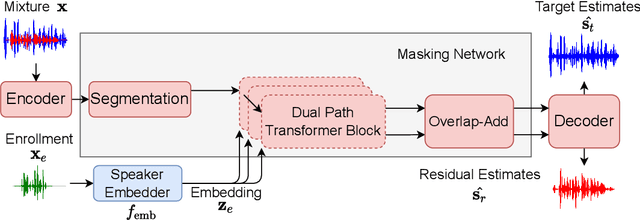
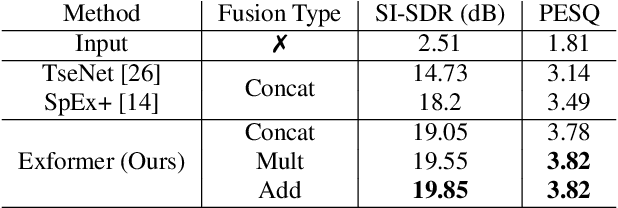
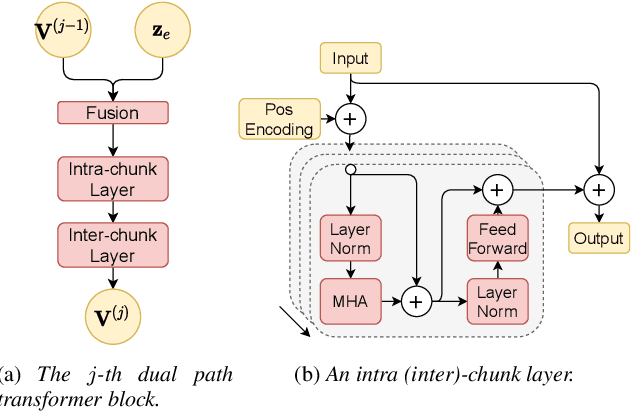
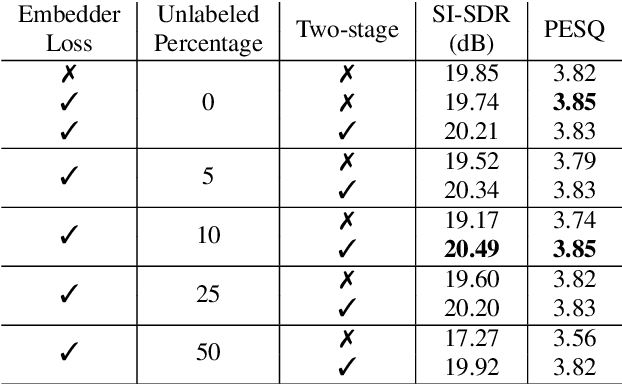
Abstract:In this work, we propose Exformer, a time-domain architecture for target speaker extraction. It consists of a pre-trained speaker embedder network and a separator network based on transformer encoder blocks. We study multiple methods to combine speaker information with the input mixture, and the resulting Exformer architecture obtains superior extraction performance compared to prior time-domain networks. Furthermore, we investigate a two-stage procedure to train the model using mixtures without reference signals upon a pre-trained supervised model. Experimental results show that the proposed semi-supervised learning procedure improves the performance of the supervised baselines.
 Add to Chrome
Add to Chrome Add to Firefox
Add to Firefox Add to Edge
Add to Edge